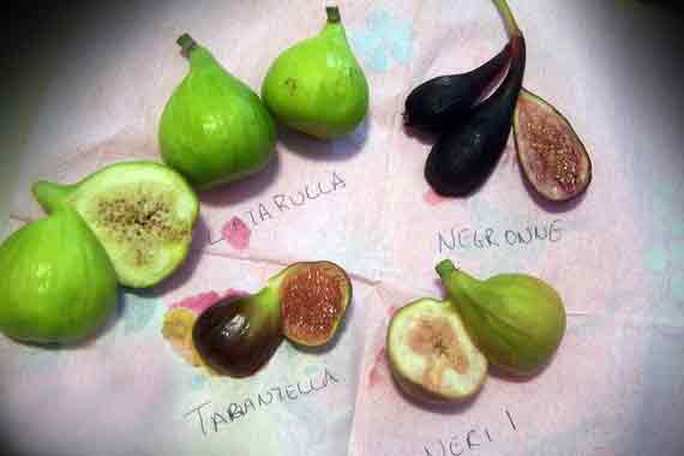 Wrapped up tight for winter Wrapped up tight for winter When I was a boy, my Dad had a large fig tree in our little backyard in the city where we lived. He would love eating the rip figs right from the tree, squishing it open between his two thumbs to show me the rich, sweet and colorful seedy fruit inside. Now as a kid, I was never all that partial to figs. I thought they were too mushy--it was a texture thing. As an adult, I discovered there's nothing like figs and cheese... especially when paired with some fresh ricotta and drizzled with honey. Of course, I'm talking about fresh figs... the dried figs are very sweet and would be best left as an ingredient in other dishes or baked goods, the way raisins are used. We lived just across the Hudson River from Manhattan. Winters were very cold back then. I remember Dad wrapping his fig tree very carefully to "put it to bed" for the winter--stuffing newspapers in between the branches, then wrapping with burlap, and then wrapping again with an old carpet. He'd cover the whole thing with a tarp. This would keep out the cold and snow and prevent the branches from freezing all the way to the ground. In the early spring, Dad would unwrap the tree carefully and if he did it properly, the branches only died back a few inches. As soon as it got warm, the tree would put out leaves again... the cycle renewing itself. Some would dig long trenches and kneel the fig trees over and then put the layering on top, but Dad always thought this was overkill.  Figs in a Pompeii fresco Figs in a Pompeii fresco Fig History In the beginning, there was the Fig. In fact, some Biblical scholars believe the Fig was the Forbidden Fruit, not the apple. One only needs to consider that it's perhaps the sweetest fruit on the planet, and to ponder the sensual flesh inside the fruit to understand why it may have well been Forbidden by God Himself. The edible fig is also one of the first plants cultivated by humans as far back as 11,000 years ago! That's about a thousand years before wheat, rye or peas were farmed. Figs were grown throughout the Middle East and of course from Greece to Italian peninsular. Cato the Elder wrote about figs that were cultivated during the time of the Roman Empire and even listed the varieties: Mariscan, African, Herculanean, Saguntine, and Black Tellanian. Fruits were eaten fresh, of course, but what made figs a valuable food source was their long storage capabilities when dried. Obviously healthy, figs are full of calcium, potassium and fiber. They were also used to produce foie gras by force feeding geese to fatten their livers. In time, figs would be grown from India all the way across the Mediterranean to Portugal. After the discovery of the New World, figs crossed the Atlantic and were grown as a steady supply of nutritious food. Fig trees can easily get through a seasonal drought, and the Mediterranean climate in Italy is best for them. Old specimens can reach gigantic proportions and grow from 40 to over 100 feet tall. When planted in colder climates, they have to be protected from the cold or they will die back nearly to the ground, putting out new shoots the next spring, but taking a large toll on the shorter cold climate's fruit production season. Its aggressive root system in warmer climates can do damage to property and foundations of buildings so they are not normally grown in urban settings. In some parts of the Orient, figs have even overgrown houses and temples. The cantankerous roots are what allows the fig to survive even in dry, rocky landscapes. A little known fact about wild figs is that for the most part, they are sterile and need a particular species of wasp to enter inside the fruiting body in order to be able to spread pollen from plant to plant. For this reason, all cultivated figs bought from growers are clones of a mother plant--that is, they are grown from branch cuttings of a plant that is a know variety for good fruit production. If cared for properly, fig trees can produce two crops of figs each year. Fig Use in Recipes Fresh figs must be eaten within a short period of time simply because they don't keep well. Dried figs last for a year or more. Fig jams are a delicious way to keep the taste of figs on hand any time of the year. Cooked figs in ancient times were used as a sweetener as we use sugar today, and can be used in a similar fashion by modern chefs. Of course, we all know the iconic Fig Newton, so we can get a fix of fig that way, but nowadays the humble fig is being elevated into alta cucina by chefs worldwide. Here are a few ways to use figs: Lisa and I grew a fig tree at our last home and enjoyed the fresh fruits. After doing the research for this article and remembering how my Dad grew and loved figs, I'm thinking that next spring I'll put in a couple of young trees in my current garden. I'll let you know how that goes... Lunga vita il fico! --Jerry Finzi You can also follow Grand Voyage Italy on: Google+ StumbleUpon Tumblr Copyright 2015-16, Jerry Finzi - All Rights Reserved
2 Comments
Rodolfo r rodriguez
11/9/2018 01:00:26 pm
Great love figs am diabetic love forbidden foods
Reply
DAVID CHEIFETZ
4/2/2019 04:39:19 pm
I have a client who wants to eat figs in Italt right from the tree.
Reply
Your comment will be posted after it is approved.
Leave a Reply. |
Categories
All
Archive
June 2024
|






 RSS Feed
RSS Feed
